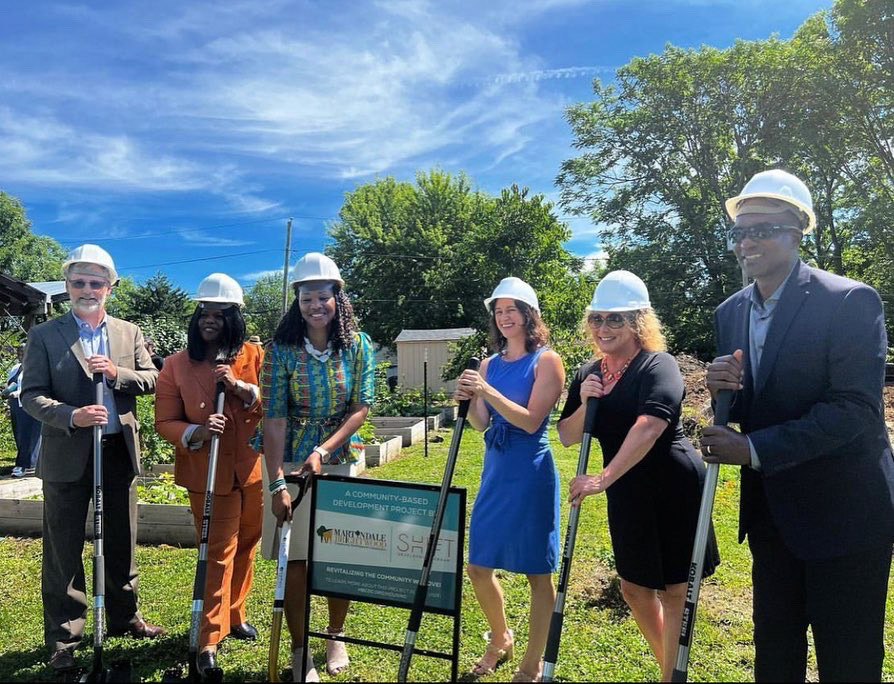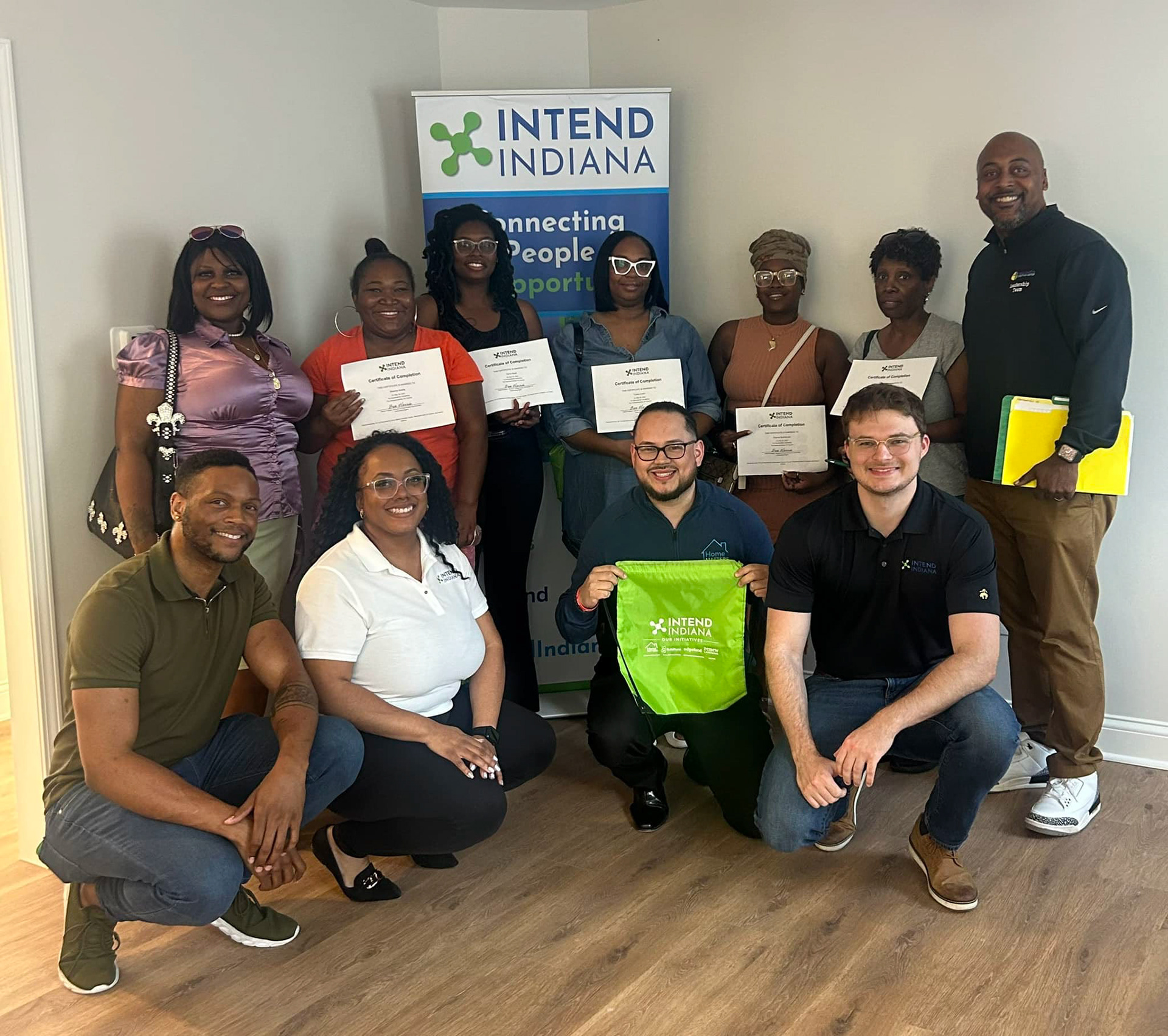Several Martindale Brightwood stakeholders are partnering to increase the supply of accessible, affordable, quality housing for the diverse people who call the neighborhood home. The Martindale Brightwood Community Development Corporation (MBCDC) has long led in the development of housing and infrastructure resources for the community and will take leadership in these Quality of Life strategies. Oasis Christian Community Development Corporation developed and manages more than 200 affordable rental units. In 2022, Edna Martin established a new community development subsidiary that has already acquired three homes for rehabilitation in 2024 and another 13 lots for development in the next five years. The Edna Martin Community Based Development Organization (EMCBDO) also partners with Intend Indiana to provide Homeowner Education that includes assistance with securing mortgage financing.
In recent years, Martindale Brightwood has seen steady growth in housing activity in recent years for both new construction and renovation with 722 residential building permits issued between 2016 and 2022. Still demand for housing has outpaced supply with 1138 applications for home purchase or improvement loans originating for Martindale Brightwood during that same six-year period. High demand for housing may contribute to a decline in the residential vacancy rate to 22% in 2022. However, housing vacancies in Martindale Brightwood are more than double the Marion County vacancy rate of 10%.
Residents have noted that new home construction has concentrated in the southwest section of the neighborhood, adjacent to the Monon Trail for new market-rate housing that attracts new residents to the neighborhood. Long time neighbors fear this new development threatens the character of Martindale Brightwood, pricing homeownership out of their reach. Some data may reinforce concerns about gentrification, including a significant increase in median assessed value of homes, from just under $24,000 in 2016 to more than $55,000 (more than double) in 2022. Racial disparities in access to home financing may also indicate signs of gentrification. Beginning in 2018, more white applicants than Black applicants have applied for mortgages to purchase houses in the neighborhood. In 2022, 38% of mortgage applicants were white compared with 27.5% of Black applicants. Mortgage approval for Martindale Brightwood homes also reflect racial disparities with 70% of white applicants approved by lenders compared to only 44% approval of Black mortgage applicants.
Overall, the Martindale Brightwood homeownership rate has decreased 10% from 2010 to 2022 and the current homeownership rate of 39% lags 10% behind Marion County and is 20% lower than Indiana. During this same period, the median monthly rent has increased from $700/month to over $1,000/month. In 2022, about 43% of Martindale Brightwood residents are burdened with housing costs greater than 30% of their monthly income. This burden falls much harder on renters, Renters report a greater burden with 55% renters spending 30% of income on housing compared to 25% of homeowners.
Fortunately, the neighborhood can rely on leadership from MBCDC, Oasis of Hope, and EMCBDO to implement strategies described in this QoL plan. Furthermore, in the last two years, several new investments have been promised for development of housing and infrastructure. In 2021, the City of Indianapolis Lift Indy program allocated $3,5 million to be used by Edna Martin and the Martindale Brightwood CDC for several redevelopment projects. That same year, the City announced a home ownership tax increment financing district (HoTIF) focusing on the Hillside Neighborhood which designates some property taxes for residential redevelopment. The 30th & Monon Project plans significant residential development immediately west of the neighborhood in former industrial areas. The Connected Communities initiative supported by the Lilly Endowment and the Central Indiana Community Foundation promises investment to better utilize access to the Monon and other Greenways, and also investment in other vehicular and pedestrian transportation options.
Creating a comprehensive housing and infrastructure strategy for an underserved community involves addressing several key aspects: housing accessibility, infrastructure development, community engagement, and sustainability.
By following these steps, the housing and infrastructure strategy for the Martindale Brightwood community can be both comprehensive and sustainable, aiming to improve residents’ quality of life and foster inclusive economic growth.

Goals And Strategies
Goal 1
Assessment and Needs Identification: Housing and Infrastructure goals, strategies and actions are based on quantitative and qualitative data that accurately describes the current reality.
Strategy 1.1
Community Consultation: Engage with community leaders, residents, and local organizations to understand the needs, concerns, and priorities regarding housing and infrastructure
Community Consultation: Engage with community leaders, residents, and local organizations to understand the needs, concerns, and priorities regarding housing and infrastructure
Strategy 1.2
Data Collection: Gather demographic information, housing conditions, infrastructure deficiencies, and environmental considerations (e.g. flood risk, brownfields)
Data Collection: Gather demographic information, housing conditions, infrastructure deficiencies, and environmental considerations (e.g. flood risk, brownfields)
Strategy 1.3
Needs Prioritization: Identify critical areas such as affordable housing, sanitation, and transportation infrastructure.
Needs Prioritization: Identify critical areas such as affordable housing, sanitation, and transportation infrastructure.
Goal 2
Housing Development: Residents have more access to affordable, quality housing options.
Housing Development: Residents have more access to affordable, quality housing options.
Strategy 2.1
Affordable Housing Initiatives: Partner with developers, nonprofits, and government agencies to increase affordable housing options through subsidies, grants, and tax incentives.
Strategy 2.2
Mixed Income Housing: Promote mixed-income developments to ensure diversity and inclusivity within the community.
Mixed Income Housing: Promote mixed-income developments to ensure diversity and inclusivity within the community.
Strategy 2.3
Renovation Programs: Establish programs to renovate, repair and upgrade existing housing stock to improve living conditions and energy efficiency.
Renovation Programs: Establish programs to renovate, repair and upgrade existing housing stock to improve living conditions and energy efficiency.
Goal 3
Infrastructure Improvement: Residents have increased mobility as well as more secure, affordable and sustainable energy.
Infrastructure Improvement: Residents have increased mobility as well as more secure, affordable and sustainable energy.
Strategy 3.1
Transportation: Enhance public transportation networks, create pedestrian friendly infrastructure, and improve road conditions to facilitate connectivity and mobility.
Transportation: Enhance public transportation networks, create pedestrian friendly infrastructure, and improve road conditions to facilitate connectivity and mobility.
Strategy 3.2
Energy Access: Promote renewable energy adoption, update electrical grids, and provide energy efficiency incentives to reduce utility costs.
Energy Access: Promote renewable energy adoption, update electrical grids, and provide energy efficiency incentives to reduce utility costs.
Goal 4
Community Empowerment and Engagement: Residents are informed, prepared, and confident to take action to improve quality of life in Martindale Brightwood.
Community Empowerment and Engagement: Residents are informed, prepared, and confident to take action to improve quality of life in Martindale Brightwood.
Strategy 4.1
Capacity Building: Offer training programs in construction skills, entrepreneurship, and community leadership to empower residents
Capacity Building: Offer training programs in construction skills, entrepreneurship, and community leadership to empower residents
Strategy 4.2
Local Governance: Foster participatory decision-making through community meetings, advisory boards, and regular updates on project progress.
Local Governance: Foster participatory decision-making through community meetings, advisory boards, and regular updates on project progress.
Strategy 4.3
Cultural Preservation: Incorporate cultural heritage into urban planning and infrastructure design to maintain community identity and pride.
Cultural Preservation: Incorporate cultural heritage into urban planning and infrastructure design to maintain community identity and pride.
Goal 5
Sustainability and Resilience: New developments promote improved environmental quality and protect the neighborhood from hazardous effects of climate change.
Sustainability and Resilience: New developments promote improved environmental quality and protect the neighborhood from hazardous effects of climate change.
Strategy 5.1
Green Infrastructure: Implement green spaces, urban gardens, and sustainable drainage systems to improve environmental quality and resilience to climate change.
Green Infrastructure: Implement green spaces, urban gardens, and sustainable drainage systems to improve environmental quality and resilience to climate change.
Strategy 5.2
Resilience Planning: Develop strategies to mitigate natural disaster risks (e.g. flooding, tornadoes) through infrastructure preparedness programs.
Resilience Planning: Develop strategies to mitigate natural disaster risks (e.g. flooding, tornadoes) through infrastructure preparedness programs.
Goal 6
Monitoring and Evaluation: Community voices guide continuous improvement of housing and infrastructure strategy implementation.
Monitoring and Evaluation: Community voices guide continuous improvement of housing and infrastructure strategy implementation.
Strategy 6.1
Feedback Mechanisms: Regularly solicit feedback from residents and stakeholders to adjust strategies and address emerging issues.
Feedback Mechanisms: Regularly solicit feedback from residents and stakeholders to adjust strategies and address emerging issues.
Goal 7
Policy & Advocacy: The neighborhood addresses root causes to overcome systemic challenges connected to housing and infrastructure, while ensuring long-term improvement in the built environment.
Policy & Advocacy: The neighborhood addresses root causes to overcome systemic challenges connected to housing and infrastructure, while ensuring long-term improvement in the built environment.
Strategy 7.1
Policy Development: Advocate for policies at local and regional levels that support affordable housing, sustainable development practices, and infrastructure investment.
Policy Development: Advocate for policies at local and regional levels that support affordable housing, sustainable development practices, and infrastructure investment.
Strategy 7.2
Legal Protections: Ensure equitable access to housing and infrastructure services through legal protections against discrimination and displacement.
Legal Protections: Ensure equitable access to housing and infrastructure services through legal protections against discrimination and displacement.
Strategy 7.3
Strategic Planning: Develop a long-term vision for the community’s growth and development, incorporating flexibility to adapt to changing economic, social, and environmental conditions.
Strategic Planning: Develop a long-term vision for the community’s growth and development, incorporating flexibility to adapt to changing economic, social, and environmental conditions.
Strategy 7.4
Legacy Planning: Foster intergenerational equity by ensuring that future generations benefit from improved housing, infrastructure, and community resources.
Legacy Planning: Foster intergenerational equity by ensuring that future generations benefit from improved housing, infrastructure, and community resources.


